Dodo Sighting In Liverpool
Posted by: Loren Coleman on September 12th, 2009
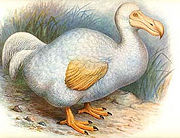
The dodo (Raphus cucullatus).
Alan Weston is reporting in today’s Liverpool Daily News that Liverpoolians have a chance to view an exhibition as “dead as a dodo.”
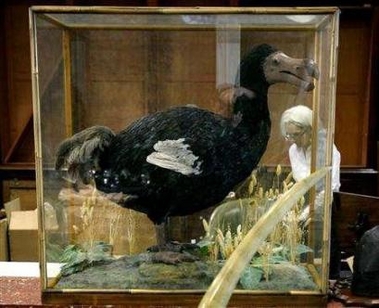
The dodo nicknamed “Fred.” The Natural History Museum, London, photo.
Weston writes that “visitors to World Museum Liverpool can get an idea of what this near-mythical creature looked like after a rare dodo skeleton was put on display. The skeleton is made up of large numbers of bones found in a swamp on the island of Mauritius, in the Indian Ocean. While the dodo has been extinct for more than 300 years, the mounted skeleton itself is believed to have been kept under wraps in the museum’s collection for at least 40 years. It is now on display for a month as part of the Hidden Treasures series, featuring items rarely seen by the public.”
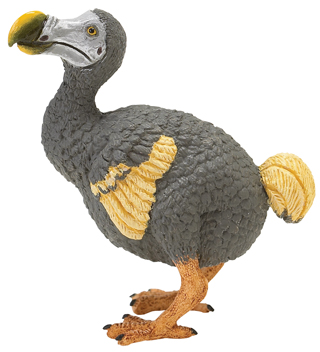
This museum quality replica of the dodo is from the company Safari Ltd.
This is the only mounted skeleton of a dodo anywhere in the world. All others are reconstructions, using goose feathers. The skeleton is quite complete although we have recently discovered that the foot bones have been skilfully carved from wood.
It’s a good skeleton, with an important story. The message is the extinction of flightless species is incredibly easy. They are on an island, and as soon as man comes along with his pigs, guns, and rats, they’re gone.
Everyone knows the dodo from the phrase “dead as a dodo,” but very few will have seen an actual skeleton of one.
Although the last reliable sighting of a living dodo was in the late 17th century, it may one day be possible to reconstruct the species with the ancient DNA from one of these bones.
Dr Clem Fisher, the museum’s curator of vertebrate zoology
The large, flightless pigeons were about 3 feet tall and were killed off by arriving sailors in Mauritius, who slaughtered the birds for food.
The skeleton was put together from the bones of different dodos found in a swamp on the island.
The only part missing is the top of the bird’s skull, or cranium. It was donated to the curator of the then Liverpool Museum in 1866, and has been in the collection ever since.
Dodos would have weighed around 50 pounds, and had grey plumage, a nine-inch beak with a hooked point, tiny wings and a tuft of curly rear feathers, writes Weston.
Cryptozoologically, sightings of birds resembling dodos have been recorded in recent years from some of the islands surrounding Mauritius. Reports of sightings of living dodos in the 1990s on Mauritius prompted William J. Gibbons to mount expeditions to search for them. None were found.
While the dodos will never fly again, perhaps they still do exisit?
^^^^^^^^^^^^^^^^^^^^^
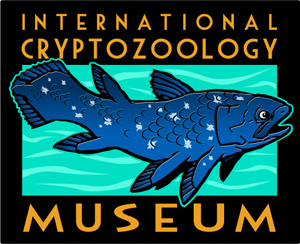
Coming soon – on Sunday, September 13th! Be prepared for some big news. There will be a major announcement about the future of the International Cryptozoology Museum in one day. Your donations are urgently requested. You can’t imagine how much they are needed now! Please, today, donate, by clicking the following button:
Thank you!!
+++
Dodo stamp illos thanks to Pib Burns.
About Loren Coleman
Loren Coleman is one of the world’s leading cryptozoologists, some say “the” leading living cryptozoologist. Certainly, he is acknowledged as the current living American researcher and writer who has most popularized cryptozoology in the late 20th and early 21st centuries.
Starting his fieldwork and investigations in 1960, after traveling and trekking extensively in pursuit of cryptozoological mysteries, Coleman began writing to share his experiences in 1969. An honorary member of Ivan T. Sanderson’s Society for the Investigation of the Unexplained in the 1970s, Coleman has been bestowed with similar honorary memberships of the North Idaho College Cryptozoology Club in 1983, and in subsequent years, that of the British Columbia Scientific Cryptozoology Club, CryptoSafari International, and other international organizations. He was also a Life Member and Benefactor of the International Society of Cryptozoology (now-defunct).
Loren Coleman’s daily blog, as a member of the Cryptomundo Team, served as an ongoing avenue of communication for the ever-growing body of cryptozoo news from 2005 through 2013. He returned as an infrequent contributor beginning Halloween week of 2015.
Coleman is the founder in 2003, and current director of the International Cryptozoology Museum in Portland, Maine.

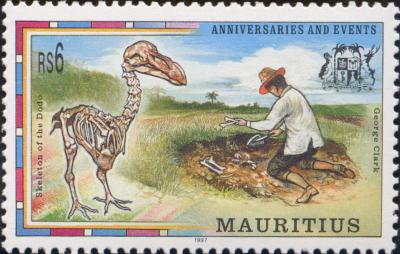
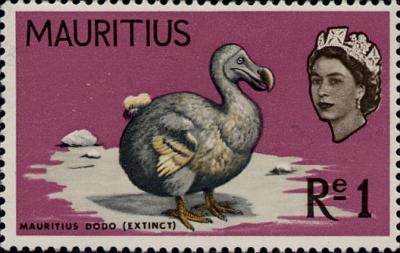









The Harvard Museum of Natural History in Cambridge has a Victorian-era Dodo reconstruction on display. They also have a very impressive preserved coelacanth specimen, a giant ground sloth skeleton, the world’s only complete Kronosaurus skeleton (42-feet-long!), and a few other exhibits that would interest crypto enthusiasts. Definitely worth a visit.
The Dodo used to walk around,
And take the sun and air.
The sun yet warms his native ground —
The Dodo is not there!
The voice which used to squawk and squeak
Is now for ever dumb —
Yet may you see his bones and beak
All in the Mu-se-um.
Actually, it was my understanding that the tale that the species was slaughtered for food was largely a myth. I have seen reports that there were some attempts to kill them for food, but that they were essentally inedible. I thought the more current theory was that they died out after pigs were introduced to the islands, and prooved a too-efficient competitor. The pigs consumed all of the nuts and roots that had previously sustaned the dodos, fairly quickly starving them out.
Quite a few extinct critters have been found alive and well recently, so yes there may still be dodos around some where.
The possible sightings of the dodo give me some small hope that the great auk may actually be surviving out there somewhere.
Since the 19 century people of Liverpool are described as ”LIVERPUDLIANS” based on a humorous and perhaps affectionate change from pool to puddle. It does sound much better.
Fortunately, the Beatles didn’t change it to LOVERPUDLIANS!
The Dodo Bird used to live on earth
breathe, eat, poop and pee.
All in all, feed, sleep, thirsts and feed
Making love so they all can give birth
Time and time passes by, you and i
have to say goodbye
to a bird that used to live.
Which is why i have to give
my attention to this life
that i thought they’d never die.
I Have to see them sleep without breath.
I must take my time to caress
the wonders of this beautiful fowl
cause they’re all in a Museum now.
Great specimen. Looks like the one in Alice in Wonderland.
This sure “takes me back.”
Could there POSSIBLY be any chance of one of these birds being still around in some remote, obscure corner of the world?
Hopefully. Fingers crossed.
Thanks, Dj Plasmic Nebula. The poem I quoted was not my own, but was written by Hilaire Belloc.
Sorry, guys, but unless the Dodo is a transdimensional entity that sometimes begs for scraps at the Carter farm, it’s extinct. Flightless birds find it hard to cross water, and if (as oldphilosopher states) they were not good to eat, seafaring humans would be unlikely to give them a lift (as we’ve done for chickens).
Very interesting, thanks. We shouldn’t be too quick to dismiss the possibility of flightless birds like the Dodo still living on the surrounding islands. I’ve just read about Mauritius and its surrounding islands on Wikipedia. It looks to me like the geology of the area can help explain why some such birds may still be around.
Currently, the closest islands in this island group – the Mascarene islands – that are mentioned are a couple of hundred miles away from Mauritius (though perhaps there are smaller ones nearer by that Wikipedia doesn’t mention). However, these islands are all located on a shallaw plateau – the Mascarene plateau, that lies over a volcanic hotspot. The plateau is 2000km long, running from the Seychelles in the north all the way to the island of Reunion, south-west of Mauritius. But it is very shallow, just 8m to 150 deep, and there are many submerged banks that were previously islands and formed a succession of islands and larger islands. The areas of land that are now underwater became submerged by erosion and rising sea-levels at the end of the ice-age (18,000 to 6,000 years ago), ie. not long ago.
Because of this geology, the whole island group forms one ecological region, with many endemic species. There were no ground-living mammals, until the Europeans settlers came and introduced pigs, rats, cats and mongooses (who presumably out-competed the ground-living flightless Dodos).
Importantly, there were other flightless birds, including another species of flightless pigeon called the Rodrigues Solitaire (related to the Dodo and presumably living on the island of Rodrigues, 350 miles away) and a flightless ibis.
So, my conclusion is that the fact that Mauritious is an island, is no reason to rule out the possibility that a few small populations of flightless pigeons related to the Dodo may still exist on some of the other islands.
I’ve just found this map of Mauritius and its surrounding islands.
There are several very small islands immediately off Mauritius – so perhaps some of these are still without mammals and might have a few Dodos? It also shows the other islands in the Mascarene Plateau, including Reunion and the Seychelles at each end and Rodrigues island which had the other flightless pigeon species (now extinct). The article above doesn’t say which ‘islands surrounding Mauritius’ have had sightings of the Dodo, but I note that there have also been reported sightings on Mauritius itself. All rather intriguing!
I presume the Fred above is a model of a dodo and the (part) dodo in blackpool museum is a reconstructed skeleton from the 1865 bone finds. Ditto another skeleton in Dublin zoo but this has a plaster of paris skull. Did these come to an end by a blow to the head or is the dodo skull particularly weak? There is another Fred which is the name given to the important dodo cave skeleton found in 2007 by the Dutch research group.
There have been considerable finds of bones in recent years and the situation is not as bad as the perspective Liverpool museum puts on it would suggest. I think we can expect to see many more articulated skeletons in the future as well as better and better DNA results. In addition I expect there is quite a lot of dodo material scattered around the world in and out of museums. I intend to ask my local museum what they have behind the scenes at my next visit, bearing in mind that from it over the centuries, boats sailed the world in large numbers.
Miss G-force I hope you are right I think survival all depends on if a suitable environment is available and our view of dodos as lazy fat helpless lumps is wrong! I suspect in fact the dodo had an ability to fatten up to weather out lean times. The remaining environment is a bit of a mystery to me. I know this area is a fast growing one in population and development.
Fhgwhgads, though the dodo may not have sailed the seven seas they did sail a couple at least to parts of Europe and there is a possibility that there was some movement within the islands courtesy of sailors. In addition there was probably movement around the islands as they rose and fell over the years.
I must say the dodo seems a fascinating subject-as I now appreciate thanks to Cryptomundo-It would make a really good tv documentary if handled right. It is also good to know the subject is hot with the Dutch research group doing another expedition to Mauritius and coming up with some good stuff.
Dodos seem a good subject for bringing back when-as I expect-DNA and the technology is available. There would be a hugh incentive from the tourist industry. Also a very good subject for cryptozoology though not perhaps meeting everybody’s criteria.
There is a large east african bird which has some similarities with a dodo. This is the shoebill, which also has a huge beak with a hook at the end. In addition I think the feathering and colouring of the two birds in some repects is not dissimilar. Then I would imagine the dodo might well have pranced about like the shoebill when walking and feeding in shallow water. Both are large birds with the shoebill going up to or nearly 5 feet tall and the dodo about 3 feet?
The kinds of differences between the two birds seem to be of a sort that could be explained by divergent evolution. The dodo not so charasmatic and interesting possibly as the shoebill because of its rather less exciting and more narrowly challenging environment. Plus the latters physical appearance which in flight might pass for a flying reptile unknown to science!
The DNA apparently doesnt show a link but there are questions about both sets of DNA, so I think the door is at least partly open on this score and knowledge of DNA is always progressing.
Clearly there is a lot of speculation here, but why not and it is worth looking at the extraordinary shoebill.
Dodos – > pigeons, doves.
Shoebills – > herons, pelicans, storks.